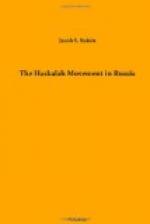These united efforts of the Government, the Maskilim, and the Jewish financiers produced an effect the like of which had perhaps been witnessed only during the Hellenistic craze, in the period of the second commonwealth of Judea. Russian Jewry began to “progress” as never before. In almost all the large cities, particularly in Odessa, St. Petersburg, and Moscow, the Jews were fast becoming Russified. Heretofore cooped up, choking each other in the Pale as in a Black Hole, they were now wild with an excessive desire for Russification. What Maimon said of a few, could now be applied to hundreds and thousands, they were “like starving persons suddenly treated to a delicious meal.” They flocked to the institutions of learning in numbers far exceeding their due proportion. They were among the reporters, contributors, and editorial writers of some of the most influential Russian journals. They entered the professions, and distinguished themselves in art.[11]
The ambition of the wealthy was no longer to have a son-in-law who was well-versed in the Torah, but a graduate from a university, the possessor of a diploma, the wearer of a uniform. The bahur lost his lustre in the presence of the “gymnasiast.” This ambition pervaded more or less all classes of Russo-Jewish society. A decade or two before, especially in the “forties,” orthodoxy had been as uncompromising as it was unenlightened. “To carry a handkerchief on the Sabbath,” as Zunser says, “to read a pamphlet of the ‘new Haskalah,’ or commit some other transgression of the sort, was sufficient to stamp one an apikoros (heretic)."[12] Reb Israel Salanter, when he learned that his son had gone to Berlin to study medicine, removed his shoes, and sat down on the ground to observe shivah (seven days of mourning). When Mattes der Sheinker (saloon-keeper) discovered that his boy Motke (later famous as Mark Antokolsky) had been playing truant from the heder, and had hidden himself in the garret to carve figures, he beat him unmercifully, because he had broken the second commandment. This was greatly altered in the latter part of the “seventies.” Jacob Prelooker has a different story to tell.
A remarkable change—he says[13]—had taken place in the minds of my parents since I had overcome all difficulties and become a student of a royal college. Not only were they reconciled to me, but they were distinctly proud of me. Old Rabbi Abraham now delighted in conversation and discussion with his grandson, who seemed to him almost like an inhabitant of another world, of the terra incognita of modern knowledge and science. In the town inhabited chiefly by Jews the very appearance of the rabbi’s grandson in the uniform of a royal college created an immense sensation, and I became naturally the hero of the day. The older generation lamented that now an end would be put to the very existence of Israel and the sacred synagogue, while the younger people envied me and were inspired to follow my example.
Such scenes occurred not only in Pinsk, but, not infrequently, in other towns of the Pale as well.




